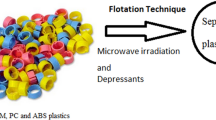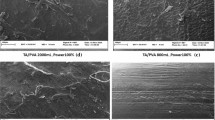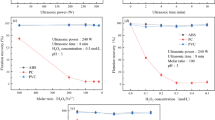Abstract
The virgin acrylonitrile butadiene styrene (ABS), polycarbonate (PC) and polyoxy methylene (POM) available in a plastic mix were separated from each other by a flotation technique with the aid of several depressants. Also, a Design-Expert® statistical software was used to predict plastics flotation using input data including conditioning time, flotation tank temperature and pH and depressants concentration. It revealed that the flotation technique was effective for separation of studied plastics by selected depressants. Understanding the adsorption–desorption phenomena and effective parameters on this process was crucial to explain the activity and selectivity of a depressant on a plastic surface. The increasing conditioning time up to 15 min had adverse effect on the floatability of the all studied plastics conditioned with tannic acid (TA). TA and methyl isobutyl carbinol (MIBC) had not any effect on floatability of PC and POM in all studied depressant concentrations. The flotation of ABS reached to 85% for flotation tank pH of 6.5 with 15 min depressant conditioning at 35 °C as flotation tank temperature. A complicate phenomenon involved and predominated in flotation of studied plastics. Proposed equations by Design-Expert® predicted close plastic flotation values when compared with corresponding experimental values.














Similar content being viewed by others
References
Thompson RC, Moore CJ, VomSaal FS, Swan SH (2009) Plastics, the environment and human health: current consensus and future trends. Philos T R Soc B 364:2153–2166
Gu F, Guo J, Zhang W, Summers PA, Hall P (2017) From waste plastics to industrial raw materials: a life cycle assessment of mechanical plastic recycling practice based on a real-world case study. Sci Total Environ 601–602:1192–1207
Negari MS, Ostad Movahed S, Ahmadpour A (2018) Separation of polyvinylchloride (PVC), polystyrene (PS) and polyethylene terephthalate (PET) granules using various chemical agents by flotation technique. Sep Purif Technol 194:368–376
Silveira AVM, Cella M, Tanabe EH, Bertuol DA (2018) Application of triboelectrostatic separation in the recycling of plastic wastes. Process Saf Environ 114:219–228
Li J, Wu G, Xu Z (2015) Tribo-charging properties of waste plastic granules in process of tribo-electrostatic separation. Waste Manag 35:36–41
Wu G, Li J, Xu Z (2013) Triboelectrostatic separation for granular plastic waste recycling: a review. Waste Manag 33:585–597
Gent M (2009) Recycling of plastic waste by density separation: prospects for optimization. Waste Manag Res 27:175–187
Gent R, Malcolm Menendez M, Toraño J, Torno S (2011) Optimization of the recovery of plastics for recycling by density media separation cyclones. Resour Conserv Recycl 55:472–482
Lee JJS, Mo JPT, Wu DY (2012) Polymer recovery from auto shredder residue by projectile separation method. Sustainability-Basel 4:643–655
Zhao Y, Lv X, Yang W, Ni H (2017) Laboratory simulations of the mixed solvent extraction recovery of dominate polymers in electronic waste. Waste Manag 69:393–399
Pappa G et al (2001) The selective dissolution/precipitation technique for polymer recycling: a pilot unit application. Resour Conserv Recycl 34:33–44
Weeden GS, Soepriatna NH, Wang NL (2015) Method for efficient recovery of high-purity polycarbonates from electronic waste. Environ Sci Technol 49:2425–2433
Singh N, Hui D, Singh R, Ahuja IPS, Feo L, Fraternali F (2017) Recycling of plastic solid waste: a state of art review and future applications. Compos Part B 115:409–422
Deiringer G, Edelmann G, Rauxloh B (1993) U.S.Patent 5248041
Gu GH, Hu YH, Qiu GZ, Wang H, Wang DZ (2002) Potential control flotation of galena in strong alkaline media. J Cent South Univ Technol 9:16–20
Izumi S, Tanaka H (1975) Method for separation of mixture of plastics, US
Burat F, Güney A, OlgaçKangal M (2009) Selective separation of virgin and postconsumer polymers (PET and PVC) by flotation method. Waste Manag 29:1807–1813
Takoungsakdakun T, Pongstabodee S (2007) Separation of mixed post-consumer PET–POM–PVC plastic waste using selective flotation. Sep Purif Technol 54:248–252
Kangal MO (2010) Selective flotation technique for separation of PET and HDPE used in drinking water bottles. Min Proc Ext Met Rev 31:214–223
Basařová P, Bartovská L, Kořínek K, Horn D (2005) The influence of flotation agent concentration on the wettability and flotability of polystyrene. J. Colloid Interf Sci 286:333–338
Yuce AE, Kilic M (2015) separation of PVC/PET mixture from plastic wastes using column flotation technique. J Environ Prot Ecol 16:705–715
Pascoe RD (2005) The use of selective depressants for the separation of ABS and 65 HIPS by froth flotation. Miner Eng 18:233–237
Yenial U, Burat F (2013) Separation of PET and PVC by flotation technique without using alkaline treatment. Min Proc Ext Met Rev 34:412–421
Güney A, Özdilek C, Kangal MO, Burat F (2015) Flotation characterization of PET and PVC in the presence of different plasticizers. Sep Purif Technol 151:47–56
Guo J, Li X, Guo Y, Ruan J, Qiao Q, Zhang J, Bi Y, Li F (2016) Research on flotation technique of separating pet from plastic packaging wastes. Proc Environ Sci 31:178–184
Beckman EJ (1992) Separation of physically co-mingled plastics using a supercritical fluid to facilitate recycling, US
Pascoe RD, Connell BO (2003) Development of a method for separation of PVC and PET using flame treatment and flotation. Miner Eng 16:1205–1212
Wang C, Wang H, Wu B, Liu Q (2014) Boiling treatment of ABS and PS plastics for flotation separation. Waste Manag 34:1206–1210
Pongstabodee S, Kunachitpimol N, Damronglerd S (2008) Combination of threestage sink–float method and selective flotation technique for separation of 67 mixed post-consumer plastic waste. Waste Manag 28:475–483
Zhang X, Zhang C, Hankett JM, Chen Z (2013) Molecular surface structural changes of plasticized PVC materials after plasma treatment. Langmuir 29:4008–4018
Qureshi A, Shah S, Pelagade S, Singh NL, Mukherjee Tripathi SA, Shripathi UPDA (2010) Surface modification of polycarbonate by plasma treatment. J Phys 208:1–6
Bakker EJ, Rem PC, Fraunholcz N (2009) Upgrading mixed polyolefin waste with magnetic density separation. Waste Manag 29:1712–1717
Vesel A, Mozetic M (2012) Surface modification and ageing of PMMA polymer by oxygen plasma treatment. Vacuum 86:634–637
Wang C, Wang H, Liu Q, Fu J, Liu Y (2014) Separation of polycarbonate and acrylonitrile–butadiene–styrene waste plastics by froth flotation combined with ammonia pretreatment. Waste Manag 34:2656–2661
Wang C, Wang H, Fu J, Zhang L, Luo C, Liu Y (2015) Flotation separation of polyvinyl chloride and polyethylene terephthalate plastics combined with 68 surface modification for recycling. Waste Manag 45:112–117
Nagy M, Skvarla J, Sisol M (2011) A possibility of using the flotation process to separate plastics. Ann Fac Eng Hunedoara 9:275
Mallampati SR, HoLee B, Mitoma Y, Simion C (2017) Heterogeneous nano-Fe/Ca/CaO catalytic ozonation for selective surface hydrophilization of plastics containing brominated and chlorinated flame retardants (B/CFRs): separation from automobile shredder residue by froth flotation. Environ Sci Pollut R 24:4469–4479
Mallampati R, Lee C, Thanh Truc NT, Lee B (2015) Hazardous PVC plastics separation from ASR by froth flotation after microwave assisted surface modification. Int Conf Adv Environ Res 87:680–749
Wang H, Wang J, Zou Q, Liu W, Wang C, Huang W (2018) Surface treatment using potassium ferrate for separation of polycarbonate and polystyrene waste plastics by froth flotation. Appl Surf Sci 448:219–229
Wang JC, Wang H (2017) Fenton treatment for flotation separation of polyvinyl chloride from plastic mixtures. Sep Purif Technol 187:415–425
IAPD Education Committee. “Amorphous and Semi-Crystalline Engineering Thermoplastics, Module 4”. Basic Plastics Education tutorials. International Association of Plastics Distributors. Archived from the original on 2 March 2012. Retrieved 13 June 2012
Stat-Ease Handbook for Experimenters, Copyright © (2018) Stat-Ease, Inc. 2021 East Hennepin Ave, Suite 480 Minneapolis, MN 55413
Chau TT, Bruckard WJ, Koh PTL, Nguyen AV (2009) A review of factors that affect contact angle and implications for flotation practice. Adv Colloid Interf 150:106–115
Shen H, Forssberg E, Pugh RJ (2002) Selective flotation separation of plastics by chemical conditioning with methyl cellulose. Resour Conserv Recycl 35:229–241
Zhao Y, Yang S, Wen H, Shen Z, Han F (2019) Adsorption behavior and selectivity mechanism of flotation reagents applied in ternary plastic mixtures. Waste Manag 87:565–576
Gregg GC, Sing KSW (1982) Adsorption, surface area and porosity, 2nd edn. Academic press, London
Masel IR (1996) Principles of adsorption and reaction on solid surfaces. Wiley, New York
Endo S, Yuyama M, Takada H (2013) Desorption kinetics of hydrophobic organic contaminants from marine plastic pellets. Mar Pollut Bull 74:125–131
Marsalek R, Pospisil J, Taraba B (2011) The influence of temperature on the adsorption of CTAB on coals. Colloid Surf A 383:80–85
Hameed BH (2007) Equilibrium and kinetics studies of 2,4,6-trichlorophenol adsorption onto activated clay. Colloid Surf A 307:45–52
Sharma P, Kaur R, Baskar Ch, Chung WJ (2010) Desalination 259:249–257
Montgomery DC (2013) Design and analysis of experiments, 8th edn. Wiley, Danvers
Hu M, Shen H, Ye S, Wang Y, Zhang J, Lv S (2018) Facile preparation of a tetraethylenepentaminefunctionalizednano magnetic composite material and its adsorption mechanism to anions: competition or cooperation. RSC Adv 8:10686–10697
Zhang Z, Zheng H (2009) Optimization for decolorization of azo dye acid green 20 by ultrasound and H2O2 using response surface methodology. J Hazard Mater 172(2–3):1388–1393
Acknowledgements
The authors sincerely thank the staffs of the AKAM company laboratory located in MarkazRoshd, the Ferdowsi University of Mashhad for their sincere cooperation. Approval no. 3/45811.
Author information
Authors and Affiliations
Corresponding author
Ethics declarations
Conflict of interest
The authors declare that they have not any financial/commercial conflicts of interest.
Additional information
Publisher's Note
Springer Nature remains neutral with regard to jurisdictional claims in published maps and institutional affiliations.
Rights and permissions
About this article
Cite this article
Davari, M.R., Ostad Movahed, S. The Flotation by Selected Depressants as an Efficient Technique for Separation of a Mixed Acrylonitrile Butadiene Styrene, Polycarbonate and Polyoxymethyleneplastics in Waste Streams. J Polym Environ 27, 1709–1720 (2019). https://doi.org/10.1007/s10924-019-01467-2
Published:
Issue Date:
DOI: https://doi.org/10.1007/s10924-019-01467-2




